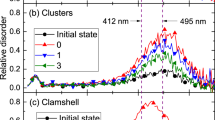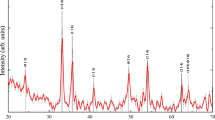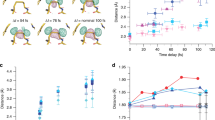Abstract
Ordering of a system of particles into its thermodynamically stable state usually proceeds by thermally activated mass transport of its constituents. Particularly at low temperature, the activation barrier often hinders equilibration—this is what prevents a glass from crystallizing1 and a pile of sand from flattening under gravity. But if the driving force for mass transport (that is, the excesss energy of the system) is increased, the activation barrier can be overcome and structural changes are initiated2. Here we report the reordering of radiation-damaged protein crystals under conditions where transport is initiated by stress rather than by thermal activation. After accumulating a certain density of radiation-induced defects during observation by transmission electron microscopy, the distorted crystal recrystallizes. The reordering is induced by stress caused by the defects at temperatures that are low enough to suppress diffusive mass transport. We propose that this defect-induced reordering might be a general phenomenon.
This is a preview of subscription content, access via your institution
Access options
Subscribe to this journal
Receive 51 print issues and online access
$199.00 per year
only $3.90 per issue
Buy this article
- Purchase on Springer Link
- Instant access to full article PDF
Prices may be subject to local taxes which are calculated during checkout




Similar content being viewed by others
References
Debenedetti, P. G. Metastable Liquids: Concepts and Principles(Princeton Univ. Press, Princeton, (1996).
Frette, V. et al . Avalanche dynamics in a pile of rice. Nature 379, 49–52 (1996).
Valpuesta, J. M. & Carrascosa, J. L. Structure of viral connectors and their function in bacteriophage assembly and DNA packaging. Q. Rev. Biophys. 27, 107–155 (1994).
Valpuesta, J. M., Carrascosa, J. L. & Henderson, R. Analysis of electron microscope images and electron diffraction patterns of thin crystals of Φ29 connectors in ice. J. Mol. Biol. 240, 281–287 (1994).
Zemlin, F., Beckmann, E. & Mast, K. D. v. d. A200 kV electron microscope with Schottky field emitter and a helium-cooled superconducting objective lens. Ultramicroscopy 63, 227–238 (1996).
Carazo, J. M., Donate, L. E., Herranz, L., Secilla, J. P. & Carrascosa, J. L. Three-dimensional reconstruction of the bacteriophage Φ29 at 1.8 nm resolution. J. Mol. Biol. 192, 853–867 (1986).
Knapek, E. Properties of organic specimens and their supports at 4 K under irradiation in an electron microscope. Ultramicroscopy 10, 71–86 (1982).
Symons, M. C. R. The pre-knock-on concept. Ultramicroscopy 10, 41–44 (1982).
Symons, M. C. R. Electron spin resonance studies of radiation damage to DNA and to proteins. Radiat. Phys. Chem. 45, 837–845 (1995).
Dubochet, J. et al . Cryo-electron microscopy of vitrified specimens. Q. Rev. Biophys. 21, 129–228 (1988).
Tadic, B. Nonuniversal scaling behavior of Barkhausen noise. Phys. Rev. Lett. 77, 3843–3846 (1996).
Bak, P., Tang, C. & Wiesenfeld, K. Self-organized criticality. Phys. Rev. A 38, 364–374 (1988).
Bak, P., Tang, C. & Wiesenfeld, K. Self-organized criticality: an explanation of 1/f noise. Phys. Rev. Lett. 59, 381–384 (1987).
Paczuski, M., Maslov, S. & Bak, P. Avalanche dynamics in evolution, growth, and depinning models. Phys. Rev. E 53, 414–443 (1996).
Bragg, W. L. AModel illustrating intercrystalline boundaries and plastic flow in metals. J. Sci. Instr. 19, 148–150 (1942).
Bragg, W. L. & Nye, J. F. Adynamical model of a crystal structure. Proc. R. Soc. Lond. A 190, 474–481 (1947).
Massobrio, C., Pontikis, V. & Martin, G. Amorphization induced by chemical disorder in crystalline NiZr2: a molecular-dynamics study based on an n-body potential. Phys. Rev. Lett. 62, 1142–1145 (1989).
Acknowledgements
The authors thank R. Schlögl and W. Storck for continuous support and fruitful discussions.
Author information
Authors and Affiliations
Corresponding author
Rights and permissions
About this article
Cite this article
Zemlin, F., Schuster, R., Beckmann, E. et al. Stress-induced recrystallization of a protein crystal by electron irradiation. Nature 399, 51–54 (1999). https://doi.org/10.1038/19947
Received:
Accepted:
Issue Date:
DOI: https://doi.org/10.1038/19947
This article is cited by
-
Stress-induced long-range ordering in spider silk
Scientific Reports (2017)
Comments
By submitting a comment you agree to abide by our Terms and Community Guidelines. If you find something abusive or that does not comply with our terms or guidelines please flag it as inappropriate.



